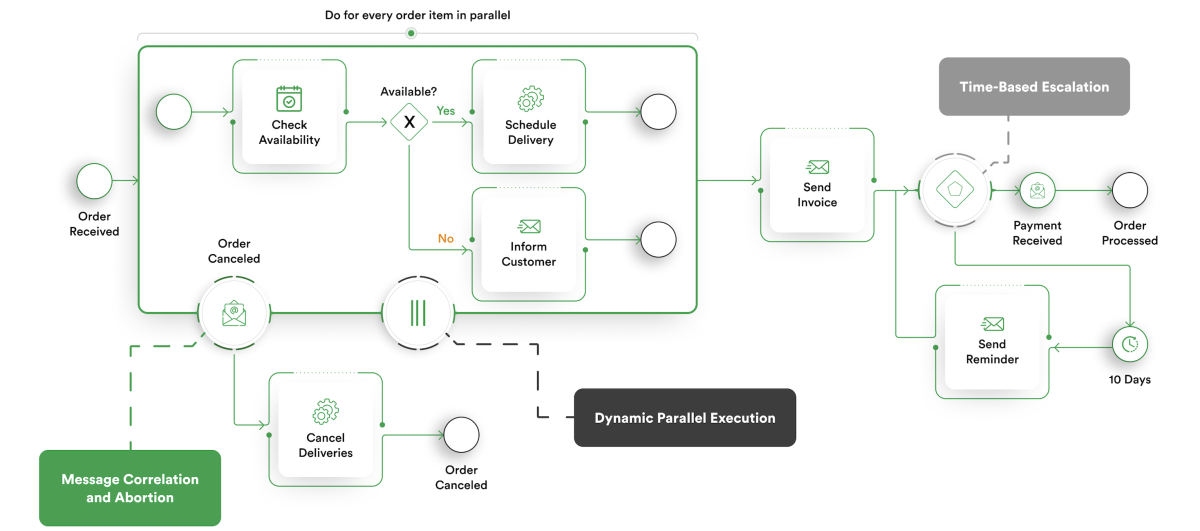
Unleashing the Power of Data: The API Economy and Open Banking
Exploring the immense potential of data-driven innovation within the financial services industry.
The global workflow orchestration market was valued at over $46 billion last year. A compound annual growth rate of 22.64% will see the market reach more than $307 billion by the end of the decade. The ever-increasing demand for automation, high-octane operational environments, and interconnected systems drives this high-value market. An added complexity is that organizations can’t afford to neglect the safety and security of their complex infrastructures (often a mix of public clouds, private clouds, and on-premises) as a trade-off for performance velocity.
Workflow orchestration requires both business logic and robust tools. Workflow orchestration tools and systems are becoming widespread. According to Gartner, almost two-thirds of surveyed organizations will introduce automated systems by 2025 to increase efficiency. But, surprisingly, only 21% of surveyed I&O leaders claim to have had a positive and fruitful experience with the introduction of automated systems. This shows that workflow orchestration, though undoubtedly necessary, can only help organizations if implemented with precision and clarity.
This blog post goes beyond simply defining workflow orchestration. It includes key examples to highlight what workflow orchestration looks like, warns against certain inevitable challenges, provides best practices to follow during workflow orchestration implementation, and briefly explores future trends.
It isn’t a challenge to understand the principles behind workflow orchestration. However, looking at examples to see how workflow orchestration can benefit organizations is important. This section spotlights four key examples of workflow orchestration: data pipelines, application deployment, IT process automation, and business process automation.
We all know that data is the primary asset of modern enterprises. That’s why the first and perhaps most important example of workflow orchestration involves data pipelines. Data pipelines are complex because data often comes in varying formats and from disparate sources. We can break down the typical data workflow into collection, storage, and analysis. Numerous other activities take place around these parent processes, all of which can be optimized by data workflow orchestration.
Data workflow orchestration via the introduction of automation technologies can provide numerous advantages, including fewer human errors, simplified workflows, empowered DevOps personnel, and high-quality and accurate data assets. Data workflow orchestration is vital because of the importance of big data analytics. Companies are reliant on large volumes of data to generate actionable business insights, deploy products and services, and outpace competitors. Data workflow orchestration can ensure that the quality, speed, and consistency of this critical data, metadata, and related processes are continuously upheld.
Workflow orchestration for application deployment involves cohering, automating, and optimizing processes within software development lifecycles. The orchestration of application deployment encompasses several processes, including designing, testing, building, deploying, managing, and maintaining software. A plethora of workflow orchestration tools can be custom-built or commissioned to strengthen and streamline these critical application deployment workflows.
Workflow orchestration for application deployment is a prominent use case because of the prevalence of CI/CD (Continuous Integration/Continuous Deployment) pipelines. This is a software development methodology that is defined by speed and automation. The success of CI/CD pipelines, DevOps environments, and other agile workflows is dependent mainly on the quality and application of workflow orchestration tools.
Modern enterprises operate out of complex IT environments, often amalgamating IaaS and PaaS services and on-premises data centers. Companies are also embracing different kinds of operational methodologies and remote work models, all of which significantly complicate key IT processes. The limitations of legacy IT processes primarily involve the human factor. Despite our immense capabilities, humans are consistently the most fragile link in an enterprise’s IT architecture. Operational inefficiencies, security breaches, compliance mishaps, and convoluted workflows in IT environments that humans often create can be addressed by introducing workflow orchestration tools. These tools can replace human workers in certain IT processes and assist them in others.
IT process automation includes a range of important use cases, including automated backups, recovery, updates, patching, onboarding and offboarding employees, and resource management. The limitations of legacy infrastructure, which is often responsible for IT workflow lags and complexities, can also be addressed by integrating robust workflow orchestration tools. The bottom line is that IT processes are the backbone of every organization; therefore, it’s one of the most important areas to introduce workflow orchestration.
The last example of workflow orchestration we’re going to explore is business process automation. Business process automation involves replacing manual work with automated tools and mechanisms to perform daily business-specific tasks. Like other examples in this list, the advantages of business process automation include cost-efficiency, consistency, fewer errors, heightened visibility, streamlined collaboration, and tightened security and compliance posture.
Key business processes that can benefit from workflow orchestration tools include onboarding and offboarding employees, contracts and order processing, and a multitude of payment processes. According to McKinsey, 52% of survey respondents claim that intelligent document management is the most advanced automation use case. Forty-five percent responded that case management platforms were an advancing example of business process automation. More and more business processes will inevitably be orchestrated. But keep in mind that the road to successful workflow orchestration is rife with challenges. We will explore the most dangerous challenges in the next section.

Example of advanced workflow patterns modelled in the BPMN standard with Camunda
Workflow orchestration can facilitate profound organizational change and bring numerous rewards. The fruits of workflow orchestration depend on how well companies identify and tackle a series of challenges. This section introduces you to the top three challenges in workflow orchestration: the complexity of integrations, scalability concerns, and the ever-looming threat of security and compliance failures.
The biggest hurdle in workflow orchestration is connecting multiple disparate tools and platforms without causing downtime, disruptions, data leaks, and other transitional issues. Certain legacy tools and platforms are incompatible for integration and must be addressed with care and caution. In some instances, organizations must decommission legacy tools and platforms that fail to integrate. The fact of the matter is that most businesses, for various reasons, are tied to certain legacy technologies. Therefore, the complexity involved in integrating these diverse technologies is an inevitable and critical hurdle to overcome.
All modern enterprises need to be able to economically and efficiently scale their ad hoc operations. This means orchestrated workflows may need to dramatically expand or contract based on various circumstances. Businesses must ensure workflow orchestration initiatives can adapt to growing workloads without disruption, complexities, and additional investments. Resource allocation within workflow orchestration projects is essential to tackle the various scalability curveballs that organizations will face.
Successful workflow orchestration can significantly strengthen an enterprise’s security and compliance posture. However, numerous security and compliance-related challenges may arise during the workflow orchestration process. Businesses must identify and protect their crown jewels, which often comprise sensitive data like personally identifiable information (PII) and intellectual property (IP). In addition to a range of security measures to prevent incidents like data breaches, supply chain attacks, and account hijacks, businesses need to maintain compliance while introducing workflow orchestration. This includes adhering to multiple industry standards and regulations that may vary from one location to another.
The challenges of complex integrations, scalability, security, and compliance may seem daunting, but it’s important to remember that they can be overcome by following a few best practices. This section highlights four best practices to successfully implement workflow orchestration.
The quality of workflow orchestration tools will largely define the success of automation initiatives. Businesses need to evaluate a broad range of tools available in the market based on a lot of business-, context-, and industry-specific criteria. Other key considerations include costs, scalability, and reputation. Examples of widely used and powerful container orchestration tools include Kubernetes, Rancher, and Amazon ECS.
Introducing workflow orchestration is a complex process that needs iterative improvements. Businesses need to regularly and closely audit and monitor orchestrated workflows to ensure smooth operations. Automation might be a perfect replacement for day-to-day and highly repetitive tasks. However, human surveillance and analysis are still vital to evaluate the quality and effectiveness of new workflow orchestration tools and tactics.
The overall quality of workflow orchestration highly depends on the quality of error-handling strategies. Errors are inevitable, and businesses need to develop robust error-handling mechanisms and optimized error responses to avoid any kind of lasting damage. It’s important to remember that every minute of uptime can help companies inch past competitors. The consequences of mishandling errors, such as downtime and disruptions, can be far-reaching and long-term. That’s why it’s essential to prioritize error management and implement and follow best practices for failovers and retries.
The hard work of implementing workflow orchestration can be undone if businesses become victims of cyber-attacks. Companies must implement encryption and access control across workflows to protect sensitive static and in-transit data. Additionally, software should be regularly updated and patched, and vulnerability scanners should be commissioned to identify and remediate a plethora of known and unknown vulnerabilities.
The most significant trends in workflow orchestration involve AI and ML. AI evolves at unprecedented speeds and continues to surprise us with its capabilities. The possibilities of AI are endless, which makes the future of workflow orchestration exciting. According to Forrester, AI will account for 6% of software spend by 2025. The vast majority of businesses will be leveraging AI in some form or another. AI and ML capabilities will augment workflow orchestration tools and projects. Additionally, AI and ML pipelines will need orchestration of their own to function effectively and efficiently.
Another major trend in this space is serverless workflow orchestration. Serverless, as we know, is a cloud-based computing model that enables devs to work on software without the hassle of maintaining critical infrastructure. Many companies are utilizing serverless models, meaning that serverless workflow orchestration will almost certainly be a significant trend. Cloud service providers like Amazon Web Services (AWS) offer serverless solutions to millions of customers around the world. Those customers are going to require innovative AWS workflow orchestration. But how do companies approach AWS workflow orchestration, other kinds of serverless workflow orchestration, and endless future trends in this space? The answer is simple. They need a powerful tech partner like rinf.tech.
Workflow orchestration involves optimizing workflows with automation. It’s a powerful and necessary technology practice in our current era. Examples of workflow orchestration include data pipelines, application deployment, IT process automation, and business process automation. Hundreds of other use cases are likely to spring up in the upcoming years. The benefits of workflow orchestration include streamlined processes, cost-savings, more robust communication, visibility, efficiency, and productivity. But businesses need to be on the lookout for a few complexities along the way.
The biggest challenges that enterprises might face with workflow orchestration include the complexity of integration, scalability concerns, and security and compliance. Organizations can mitigate these challenges by following best practices such as choosing the right tools, conducting regular audits, enforcing robust error management protocols, and prioritizing security.
Workflow orchestration can transform your organization and pave the way toward an automated future. Working with a tech partner like rinf.tech can help you do so responsibly, safely, and effectively.

Exploring the immense potential of data-driven innovation within the financial services industry.

A comprehensive overview of how fintech innovations drive significant changes in the retail industry.

Examining AI’s diverse effects on finance, delving into its advantages and obstacles, aiming to understand its transformative influence and future impact on the sector.
Copyright © 2023 rinf.tech. All Rights Reserved.
Terms & Conditions. Cookie Policy. Privacy Policy.
Politica Avertizari de Integritate (RO)